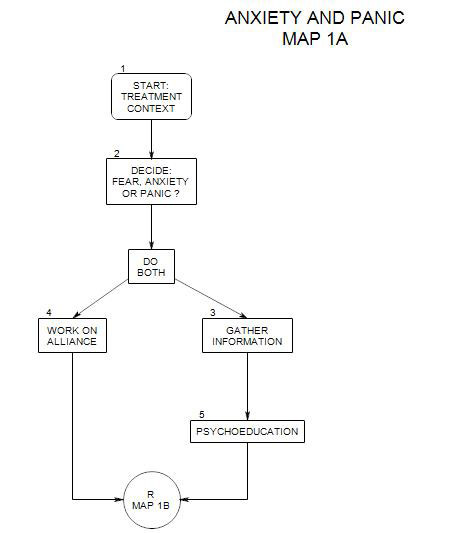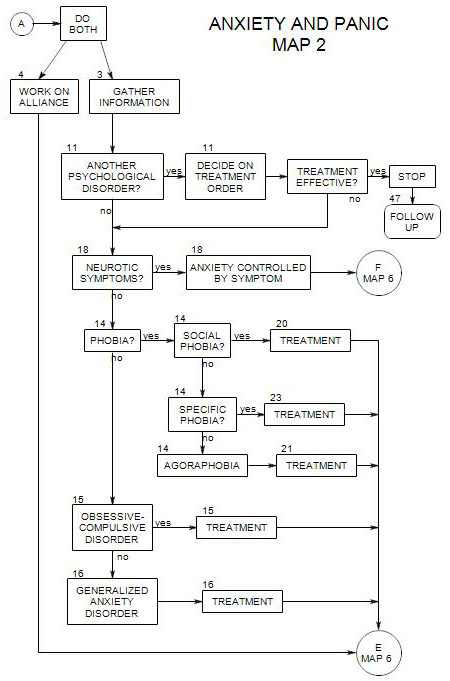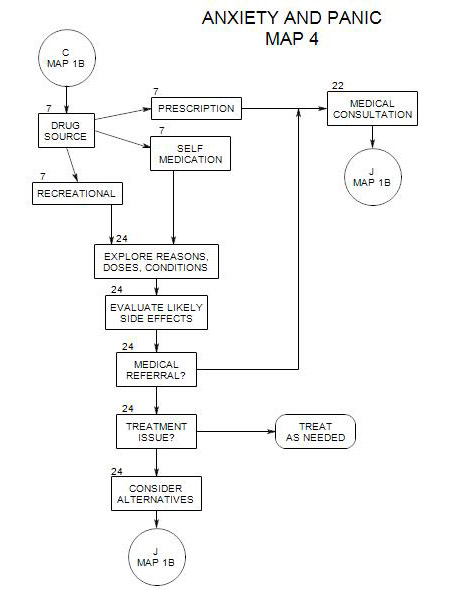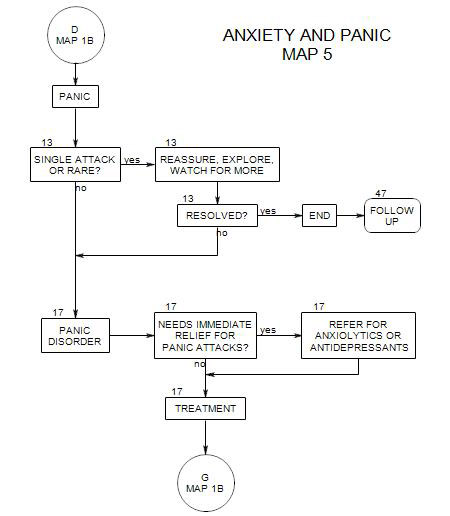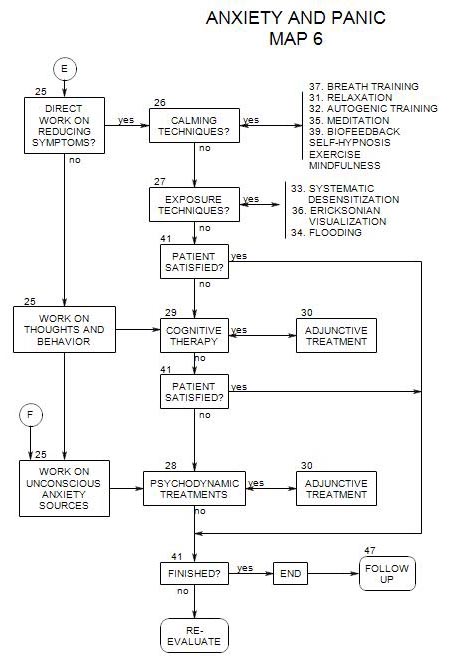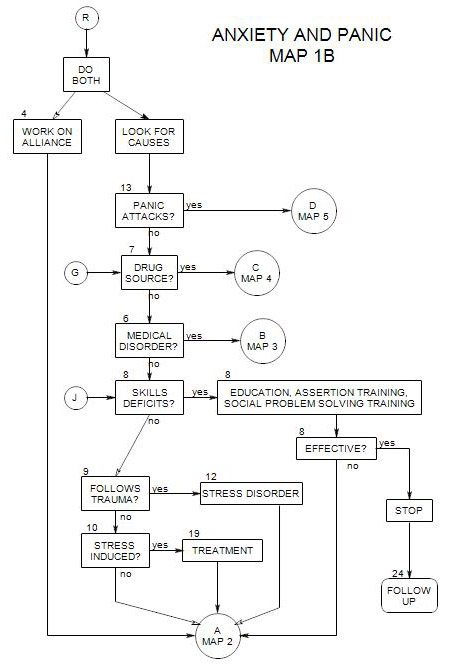
SECTIONS: 4 | 6 | 7 | 8 | 9 | 10 | 12 | 13 | 19 | 24
-
Follows Section 18 on Map 2
Follows Section 25 and Section 41 on Map 6.
By psychodynamic treatments is meant a range of therapies, directly or indirectly derived from the work of Freud. They include psychoanalysis, psychoanalytic psychotherapy, gestalt therapy, Jungian analysis, object relations and ego psychology.
28a. General Approach
Within a psychodynamic approach, a symptom is treated as part of the larger context in which it appears. Behavior and conscious experience are seen as “-part of a more complex, interconnected system of thoughts, feelings, attitudes and motives” (Almond, 1997, p.151). You must treat the symptom as an aspect of the person, his/her history and interpersonal relationships.
Symptoms, including anxiety, are assumed to have hidden meanings for the patient. These meanings must be brought to conscious awareness and examined. Then the patient can face them – possibly gradually – from a more adaptive perspective. As a person gains conscious control of his/her way of operating and latent themes, symptoms tend to lose their power and fade away.
A full understanding of the source of the person’s anxiety may involve understanding his/her defenses and how they are used, as well as his/her ability to function in a wide range of areas, including work, play, love, family life, friendships, etc. Anything about the person’s current life, personal history, and family history may be relevant. A psychodynamic therapist may be interested in a patient’s life style, coping patterns, and self-evaluation.
The effect of successful treatment is not only reduction in the person’s anxiety and other symptoms, but also-
- a greater sense of personal freedom.
- greater cognitive flexibility.
- more stable and effective sense of identity.
- improved interpersonal relationships.
- Increased self esteem.
28b. How it works
Because of the complexity of issues leading a person to develop symptoms, including anxiety, a psychodynamic approach makes relatively few assumptions about the origins of the symptoms. Rather the therapist participates in the exploration while providing varying amounts of direction as needed.
The therapist may explore a variety of areas of the person’s life and try to help him/her gain insight into his/her own functioning (Stricker and Gold, 2005, p.226). These areas include-
- how the person is repeating his/her personal history without being aware of it.
- the warded-off, unconscious meanings of his/her life experience.
- the nature and effects of the person’s intrapsychic conflict.
- the extent to which current relationships repeat earlier relationships with parents and other significant people.
The content of therapeutic exploration (Stricker and Gold, 2005, p. 227) may include:
- Life history.
- Current relationships.
- Feelings.
- Fantasies and dreams.
- Behaviors.
The therapist listens to the patient for defensive activity as well as hidden themes and works to bring these issues to the patient’s conscious awareness and control.
When hidden themes are approached in treatment, the patient defends against awareness of them in customary ways, providing the therapist with an opportunity to observe the defensive activity and point it out, as well as assisting the patient in handling the themes more effectively. Pointing out defenses makes it more difficult for the person to continue using them (Wachtel, 1997, pp. 198, 202).
When defenses are identified, several things can happen, including:
- The person may gain greater awareness of his/her own defensive pattern.
- He/she may on occasion not defend in that particular way.
- The dangerous thought or impulse that had been defended against may be more accessible to conscious awareness.
- If the dangerous thought or impulse is more accessible, the person may become more anxious, at least temporarily.
- The person also may be better able to deal with the thought or impulse directly.
28c. Psychoanalysis
Psychoanalysis is more intense and frequent, with greater focus on the patient’s defenses, unconscious processes, transference reactions to the therapist, etc. (Almond, 1997, p.169). In psychoanalysis, there is greater opportunity to observe some aspects of the patient’s cognitive and emotional functioning [especially in relation to the psychoanalytic setting of introspection and interpersonal deprivation]. At the same time, there is less opportunity to observe other aspects of the person, because the psychoanalytic situation itself is very restrictive. Also, classical psychoanalysis precludes adjunctive treatment, except to the extent that the patient uses the results of analysis in his/her real life and then processes the outcomes in session.
28d. Adjunctive treatment
Cognitive Therapy
Psychodynamic treatment may include many techniques in common with cognitive therapy, such as re-framing
Behavioral Therapy
Psychodynamic psychotherapy is similar to imaginal exposure with response prevention, in that-
- the patient is encouraged to relax.
- the patient self regulates the order of presentation of anxiety producing images or thoughts.
- the therapist works to keep the patient focused on the anxiety producing thoughts or images in various ways, including interpretation of defenses and simple re-focusing on the image avoided.
- fears are extinguished at least partly as a consequence of continued exposure while relaxed.
The patient-therapist relationship is an important ingredient for change. It is not necessarily undermined by interjection of more active or explicit interventions (Wachtel, 1997, p.190).
It is possible that behavioral interventions can lead to increased understanding.
Once it’s time to work on a specific anxiety-producing issue, rather than just continue talking about it, focused behavioral techniques can be helpful (Wachtel, 1977, pp. 203, 205). At the same time, continued exploration without action may produce diminishing returns.
Calming Techniques
Psychodynamic therapy typically includes relaxation, if not explicitly, then as part of its approach. Among other things, it often provides an opportunity for the emergence of disturbing thoughts or peculiar body sensations, that can then be explored.
Calming techniques, such as systematic relaxation or autogenic training, can also provide an opportunity for the appearance of disturbing thoughts or peculiar body sensations that can be explored in psychodynamic treatment (Linden and Lenz, 1997, p.135).
